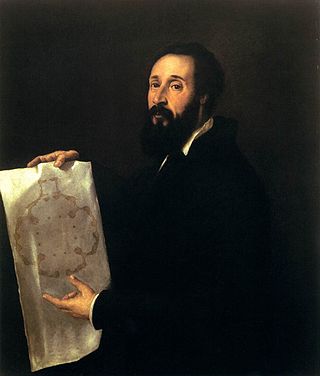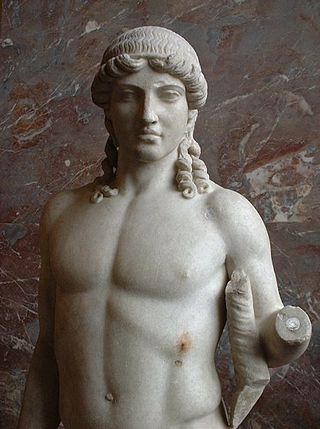
Lombardy is an administrative region of Italy that covers 23,844 km2 (9,206 sq mi); it is located in the northern part of the country and has a population of about 10 million people, constituting more than one-sixth of Italy's population. It is the third most populous region in the European Union. Over a fifth of Italy's gross domestic product (GDP) is produced in the region.

Mantua is a city and comune in Lombardy, Italy, and capital of the province of the same name.

Solferino is a small town and municipality in the province of Mantua, Lombardy, northern Italy, approximately 10 kilometres (6.2 mi) south of Lake Garda.

Giulio Pippi, known as Giulio Romano, was an Italian painter and architect. He was a pupil of Raphael, and his stylistic deviations from High Renaissance classicism help define the sixteenth-century style known as Mannerism. Giulio's drawings have long been treasured by collectors; contemporary prints of them engraved by Marcantonio Raimondi were a significant contribution to the spread of sixteenth-century Italian style throughout Europe.

Fano is a town and comune of the province of Pesaro and Urbino in the Marche region of Italy. It is a beach resort 12 kilometres southeast of Pesaro, located where the Via Flaminia reaches the Adriatic Sea. It is the third city in the region by population after Ancona and Pesaro.

A mantua is an article of women's clothing worn in the late 17th century and 18th century. Initially a loose gown, the later mantua was an overgown or robe typically worn over stays, stomacher and either a co-ordinating or contrasting petticoat.

The Palazzo Ducale di Mantova is a group of buildings in Mantua, Lombardy, northern Italy, built between the 14th and the 17th century mainly by the noble family of Gonzaga as their royal residence in the capital of their Duchy. The buildings are connected by corridors and galleries and are enriched by inner courts and wide gardens. The complex includes some 500 rooms and occupies an area of c. 34,000 m2, which make it the sixth largest palace in Europe after the palaces of the Vatican, the Louvre Palace, the Palace of Versailles, the Royal Palace of Caserta and the Castle of Fontainebleau. It has more than 500 rooms and contains seven gardens and eight courtyards. Although most famous for Mantegna's frescos in the Camera degli Sposi, they have many other very significant architectural and painted elements.

Asola is a comune in the province of Mantua, Lombardy. It received the honorary title of city with a presidential decree of October 23, 1951.

Piadena is a former comune in the Province of Cremona, Italy. On January 1, 2019 it merged with Drizzona to form Piadena Drizzona.

Cavriana is a comune (municipality) in the Province of Mantua in the Italian region Lombardy, part of the municipalities of Alto Mantovano.

Gazoldo degli Ippoliti is a comune (municipality) in the Province of Mantua in the Italian region Lombardy, located about 110 kilometres (68 mi) east of Milan and about 15 kilometres (9 mi) west of Mantua.

Viadana is a comune (municipality) in the Province of Mantua in the Italian region Lombardy, located about 120 kilometres (75 mi) southeast of Milan and about 35 kilometres (22 mi) southwest of Mantua.

Villimpenta is a comune (municipality) in the Province of Mantua in the Italian region Lombardy, located about 150 kilometres (93 mi) east of Milan and about 20 kilometres (12 mi) east of Mantua.
Virgilio is a frazione of the comune (municipality) of Borgo Virgilio in the Province of Mantua in the Italian region Lombardy, located about 130 kilometres (81 mi) southeast of Milan and about 6 kilometres (4 mi) south of Mantua. It was a separate comune until 2014.

Volta Mantovana is a comune (municipality) in the Province of Mantua in the Italian region Lombardy, located about 120 kilometres (75 mi) east of Milan and about 20 kilometres (12 mi) northwest of Mantua.

Montalto delle Marche is a comune (municipality) and former Latin catholic bishopric in the Province of Ascoli Piceno in the Italian region Le Marche, located in the hilly area that goes from the Adriatic cost to the Sibillini Mountains, at a distance of about 70 kilometres (43 mi) south of Ancona and about 15 kilometres (9 mi) north of Ascoli Piceno, with a population of 1 991 inhabitants. The municipal territory covers a 34 km² area.

The Apollo of Mantua and its variants are early forms of the Apollo Citharoedus statue type, in which the god holds the cithara in his left arm. The type-piece, the first example discovered, is named for its location at Mantua; the type is represented by neo-Attic Imperial Roman copies of the late 1st or early 2nd century, modelled upon a supposed Greek bronze original made in the second quarter of the 5th century BCE, in a style similar to works of Polyclitus but more archaic. The Apollo held the cythara against his extended left arm, of which in the Louvre example (illustration) a fragment of one twisting scrolling horn upright remains against his biceps.

The Lovers of Valdaro, or Valdaro Lovers, are a pair of human skeletons dated as approximately 6,000 years old. They were discovered by archaeologists at a Neolithic tomb in San Giorgio near Mantua, Italy, in 2007. The two individuals were buried face to face with their arms around each other, in a position reminiscent of a "lovers' embrace".

Mantua is a municipality and town in the Pinar del Río Province of Cuba.

The Marquisate or Margraviate of Mantua was a margraviate located in Lombardy, Northern Italy. Placed under the sovereignty of the House of Gonzaga since its erection in 1433, it was further raised to Duchy in 1530.





















